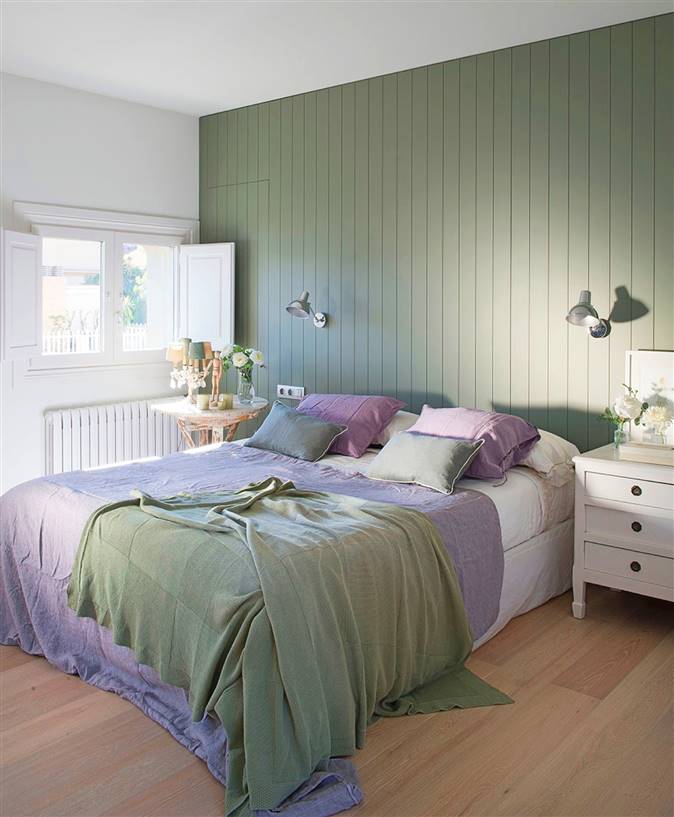Painting the walls is the fastest and most effective way to transform the decoration of your house. Do you want to paint like a pro? Follow these tips and you will be able to give all rooms a perfect finish
Painting the house is undoubtedly a reform ten. Not only do you “clean” the face of the walls –which, with use, accumulate scratches, scratches and even some scribbles if there are little ones at home–, but also, just by changing the color, your house will look like another. Give it a lighter tone and you will have the feeling that the meters have been stretched; a more intense one, and the space will look more cozy and collected; a glossy finish, and it will look like you’ve opened a new window in the living room … The transformative power of paint is enormous. If you dare to paint your house, with these 10 professional tips and tricks, you can do it yourself. And for very little money!
PLAN WHERE TO START
If you want to paint the whole house, which room will be the first? The ideal is to clear the rooms as much as possible. If you paint the emptiest one first, it will help you release the rest and facilitate movement.
Prepare the material. Check if you have everything (painter’s tape, plastic and protective paper, putty, sandpaper, spatula, large and small roller, bucket for rollers, trowel, paint and enamel). If you have old sheets, you can save on plastic.
TRY DIFFERENT COLORS TO GET THERE
If you are in doubt about the color, brush on walls where the light falls differently and look at them at different times of the day. Keep in mind that the paint darkens when it dries.
A special color? The different paint firms offer a very extensive palette of color references to choose from, a very practical option, especially if you want to later repaint a room or do revisions. If you want to make the mixture yourself, you should start with a white paint and be careful, as some are blue.
PAINTING YOURSELF AN APARTMENT OF 80 M2 CAN COST YOU ABOUT € 260. IF IT IS MADE BY A PROFESSIONAL, IT COULD BE ABOUT € 1,200
PREPARE THE WALLS WELL AND MAKE ARRANGEMENTS
If they are in poor condition, you have to sand them well, clean them of the dust created, give them a primer and putty before painting. Paint, by itself, does not remove blemishes.
Mini-flaws? You only need some caulk for small cracks and holes. Wait for it to dry, as sometimes you have to re-caulk. Then sand and clean.
PAPER AND STUCCO: WHAT DO I DO WITH THEM?
It is a cumbersome and delicate job, so it is best to have a professional. If there is stucco, the ideal is to remove it, especially if the grain is coarse. If it is very fine and is well held, the wall can be paved with putty.
Paper out! You have to tear it off, sand, fix or sealer, up to three layers of putty and at least two of paint.
PROTECT FURNITURE AND SURFACES
Put painter’s tape on non-wood baseboards, corners of ceilings, doors and frames – if they are wood, they will also need to be painted – and cover the tape on the blinds. The switches, if you can remove them; if not, tape them too. Better paper than cardboard on the ground, because paper is flexible and repels more than cardboard.
CHOOSE THE MOST SUITABLE PAINT
If the walls are in good condition, you can use plastic paint for all rooms, including the kitchen and bathroom. In addition, they are increasingly natural, so they hardly give off the smell of paint. But you have other options:
Thixotropic. With a great covering power, it is ideal for walls with grease, smoke, humidity and even mold and rust stains.
Anti-allergies. They prevent the proliferation of mites and fungi, and minimize the emission of volatile compounds (best for allergy sufferers).
100% Eco. They are breathable and you will recognize them because they have the European ecological label (Ecolabel).
With odor and anti-odor. There are paints that can even perfume your home because they have natural essences that slowly release aroma. Of course, the effect will last only a few days. And you can also do the opposite, neutralize odors with paints that absorb them. They are photocatalytic.
And the enamels? Choose them acrylic and not synthetic: you will reduce solvents. Although you should know that, according to professionals, better results are obtained with plastic paint.
CEILINGS, CORNERS AND WALLS
Start with the ceiling to cover the drops that fall on the walls. But if there are defects to caulk, start there and take the opportunity to paint corners.
Smooth corners. To avoid the difference between the corner brush trail and the rest of the wall, paint them first, with a brush, and blend the line with a roller.
IT’S TIME FOR THE CARPENTRY
Paint the doors and carpentry with a flat trowel and small, very short-nap or foam rollers. The ideal is to work with two: a wet one with which you load the paint surface and another dry, with which you comb it
Paint freehand! And do not put painter’s tape on the wall to avoid staining it, since when you remove it you can lift the paint and the remedy will be worse.
SIX HOURS LATER, ANOTHER LAYER
Open the windows wide so that the paint dries well and quickly. In the case of plastic paint, wait at least six hours between coats. If it is enamel, pay close attention to the instructions on the container.
Monolayer paint. If you use this type of paint, you will not have to give it a second coat, although the application may cost you a bit more. Evaluate it well before deciding.
REMOVE THE TAPE AND MAKE TOUCHES
Once it has dried, don’t wait to remove the tape from the whole house. If you leave it and it dries, chances are high that it will break, leave a trace of glue on the wall, or take the paint with it.
Final touches. Once everything is clean, take a look and with a small brush or a small roller, fix any damage.
And now that? You see yourself painting without problem, right? Well for it. You have a few days to choose colors. Prepare everything and you will start the month of April with a new home.


